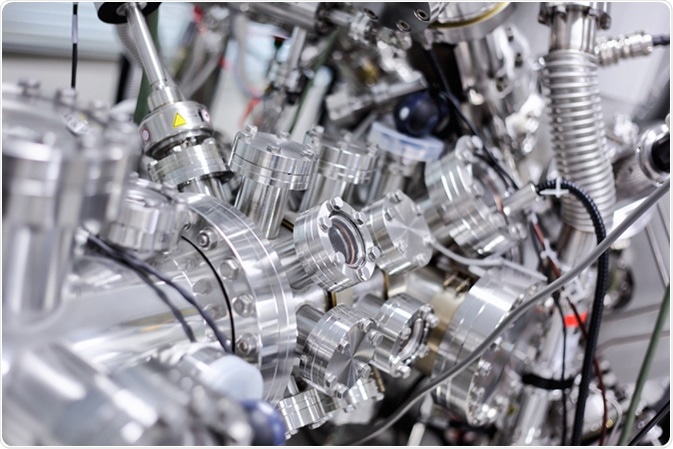Absorption spectroscopy is one of the many techniques that utilize spectroscopic principles to study components of a mixture of substances. These are used to measure the absorption of radiation following interaction with a sample of the substance under study, which depends upon the frequency or wavelength of the radiated energy.
The substance is subjected to radiation in the form of photons which it absorbs. This causes the inner shell electrons to become excited, moving into the outer orbitals and then back into the inner shells which have been newly emptied. During this fall back they emit energy, in the form of radiation. Each atom has specific absorption energies which blueprint its atomic structure; therefore, measuring the frequency of the X-rays emitted helps to study the structure and composition of the element as well as enabling research into chemical bonding.

View of part of an ultra-high vacuum chamber of a high performance X-ray photoelectron spectrometer for photoelectron spectroscopy (XPS) and parallel imaging (imaging XPS). Image Credit: Alexander Gatsenko / Shutterstock
Picosecond Absorption Spectroscopy
Picosecond absorption spectroscopy is a more advanced extension of the time-resolved absorption spectrum analysis technology. It performs measurements of picosecond absorption spectra within extremely brief durations. This helps to analyze processes such as the formation and decay of photoreactive intermediate species and states in solutions or solids, or within membranes.
It is possible to use the streak camera to detect time-resolved absorption measurements at multiple wavelengths in the same shot, so that both the spectra and the images are measured at the same time. This may be equated to the astonishing feat of photographing an irreversible phenomenon.
Picosecond Laser Pulses
Nowadays mode-locked lasers have come into use; this refers to the use of an optical technique which allows the production of extremely short-lived laser pulses. It makes use of the fact that a fixed-phase relationship can be forged between the longitudinal modes of the resonant cavity of the laser, with the interference between these modes causing the generation of a train of pulses of extremely short duration.
This is the most essential step in the generation of laser pulses which last for only picoseconds (10 -12 seconds) and femtoseconds (10 -15 seconds). In such a phase, more than one pulse can go around and around in the laser resonator, depending on the setting with respect to the round-trip time and the number of pulses.
The importance of these picosecond-duration pulses is in their ability to let us visualize the highly transient species and states of various particles that participate in a physical or chemical reaction triggered by exposure to light photons. The formation and decay of these species can be studied directly, which enables the study of the mechanisms underlying many complex reactions. The electronic structure and nuclear geometry of short-lived states of many photoexcited molecules. These include metal-complexes and organoporphyrins, which play a central role in the synthesis of biological probes and photomolecular devices. Picosecond absorption spectroscopy helps researchers trace the excited electron’s progress through the various regions of space and orbitals.
Equipment
The equipment used includes Nd 3+ Yttrium-aluminium-garnet lasers and synchronously pumped dye lasers, with recording devices such as a streak camera for transient absorption spectrum detection and two-dimensional photodiode arrays. Computerized data analysis helps to obtain an output from the picosecond absorption spectroscopy which can be easily interpreted.
Applications
Some processes which have been studied in this manner include the vibrational relaxation of naphthazarin and photo-excited molecules; photodissociation of haloarenes; and intermolecular electron transfer between organic aromatic molecules. Much work is going on to study the intricacies of the photosynthetic reaction center, for instance, which is one of the most marvellous photochemical molecular devices in creation. It bridges the gap between the molecular and material forms of matter, such as electron transfer in a highly directed manner following the absorption of light.
References
- https://en.wikipedia.org/wiki/Mode-locking
- https://www.rp-photonics.com/mode_locking.html
- http://pubs.acs.org/doi/pdf/10.1021/ac00261a002
- http://pubs.acs.org/doi/full/10.1021/jp3023088
- http://www.andor.com/learning-academy/transient-spectroscopy-an-introduction-to-pump-probe-spectroscopy
Further Reading
Last Updated: Feb 26, 2019